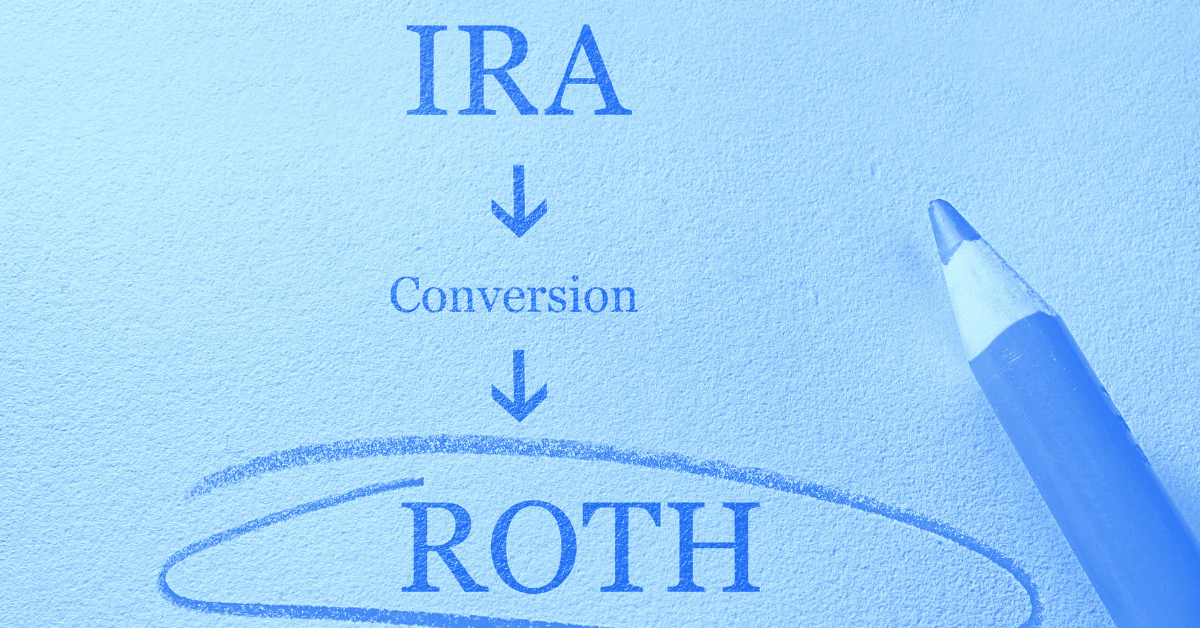5 Roth Moves: 2 Warnings & 1 Opportunity
Share this

6.5 MIN READ
In financial planning, one particular factor that provides numerous opportunities is taxation. The taxes we’ll pay over time are an integral part of our present and future cash flow and savings considerations. Bearing your taxable allocations in mind, you may be considering various Roth conversion transactions. There are several reasons you should think about converting your tax-deferred savings to Roth. In this singular discussion, I’m delaying referring to Roth accounts as tax-free because I’m going to share some instances you need to be careful, or the transaction won’t be very tax-free at all! To be fair, if we’re converting something to Roth, there’s a good chance that we anticipate tax but hope to minimize it. Let’s look at it this way:
-
- SCENARIO #1 – Qualified Retirement Plan (QRP) rollovers to Traditional, Rollover IRAs and Roth IRAs (not conversions but fit in our context) = OK
- SCENARIO #2 – Non-deductible IRA converted to Roth (Simple Backdoor Roth), no other IRAs = OK.
- SCENARIO #3 – Same as #2, except with other IRAs = Caution!
- SCENARIO #4 – Same as #2, except you have a SIMPLE or SEP plan at work = Caution!
- SCENARIO #5 – QRP plus #2 or #3 = Opportunity!
Honestly, the most challenging part of all of this is keeping the jargon straight? What do I even mean by QRP, rollover, traditional, non-deductible, Roth, SIMPLE, or SEP? Here’s a helpful bit of financial literacy for you to keep in your pocket. If you have any of these series of numbered retirement plans at work; 401(a), 401(k), 403(b), or 457, you have a qualified retirement plan (QRP) which means that they follow the same special rules which make them “qualified.” You should also know that 457s follow slightly separated regulations than the others. Traditional IRAs are individual retirement accounts or annuities that you saved money into and deducted your savings from your taxable income the year of contributions. Rollover IRAs are another name for Traditionals, except that the funding started in a retirement plan at work and moved out of the work plan at some point. Non-deductible IRAs are Traditional IRAs that don’t lower your income at tax time. Maybe you didn’t qualify for the deduction in this. But the growth on those assets will grow tax-deferred and that growth portion of the account will be taxed at ordinary income when you distribute from the account. This is a considerable distinction from Roth IRAs. Roths are also not deductible at tax time, but everything inside grows tax-free and will not be taxed when you take it out (if you follow some rules, of course). SIMPLEs and SEPs are both tax-deferring retirement plans that your employer puts together for you (or you made yourself if you’re self-employed). The critical distinction is that both of these accounts are IRAs at the end of the day, individual accounts in your name. You may never care to know the legal difference between all of these, but you will be well served by actually using their names when talking about what you have because it’ll lead to more specific questions, thus better answers.
QRP ROLLOVERS TO TRADITIONAL AND ROTH ACCOUNTS
SCENARIO #1 – You’ve diligently saved to a QRP at work. Maybe you have some of those saving in Roth, some in after-tax savings (remember, they’re not the same thing), and you have some tax-deferred savings. Roth and after-tax contributions are nearly always deferrals you made into the account that did not lower your taxable income for the year contributed. Tax-deferred assets may have come from your employee deferrals out of your pay, which did reduce your taxable income that year, or maybe, they’re from employer matches, profit shares, and non-elected contributions. Either way, these tax-deferred amounts will someday be taxed, where the latter was in the withholdings on your W-2. When you leave your employer, typically, you would be told to open a Roth IRA and a Traditional IRA. Then you could complete one form with your old company’s retirement plan and send the differently taxed portions to the right accounts without incurring a bill from the IRS. This became more clear in 2014 that a single distribution could go to multiple accounts; pre-tax goes to IRA, after-tax and Roth go to Roth IRA. Both transactions are rollovers and will not incur tax if done correctly. We haven’t yet described any variation of Roth conversion, so we’re clear. Most opinions say you shouldn’t keep assets in your old plan; I’m telling you always to consider whether this is the best advice for you (which it might be). Follow the rules of transfer = OK, no tax bill!
The result, let’s say, is you have a rollover IRA from that last job you held (because you went to an IRA instead of your new company plan) and you have that Roth IRA, so those two accounts we established above. Let’s talk about Roth conversions…
4 ROTH CONVERSIONS
If you decide to convert your Rollover IRA into a Roth IRA, the transaction is quite straightforward. You’ll pay ordinary income taxes on the entire balance of your Rollover IRA, but now all of those assets combined with your previous Roth account will grow and eventually distribute tax-free.
SCENARIO #2 – Conversions aren’t often that easy. I regularly see instances where families don’t qualify to contribute to Roth IRAs directly, so they look to leverage back-door contributions. That’s where you commit money to a traditional IRA, skip the deduction on your taxes (we’ll call it after-tax, and you track it on your Form 8606 each year), and then convert it to a Roth. If done correctly, there is no tax bill, and these savings will grow and distribute tax-free in the future, as previously described. Let’s recap: take an after-tax contribution in a traditional IRA “shell” and convert it into a Roth IRA. With minimal (no) growth before conversion = OK, no tax bill!
SCENARIO #3 (warning #1) – Insert the first monkey-wrench here. If you have any other Traditional IRAs or IRAs with both pre- and post-tax money in them, what you thought was going to be a tax-free transaction is going to get taxed. It’s called the pro-rata rule. The IRS aggregates these tax-deferred accounts and looks at them as if they were one. Then they proportionally rate your tax-deferred portions with the non-deductible contribution, and the majority of your transaction just became taxable! Whoops. You have money that hasn’t been taxed yet in your IRA before conversion or other IRAs, in addition to your non-deductible IRA = Warning! You’ll pay tax on this conversion.
SCENARIO #4 (warning #2) – Take that previous scenario and consider that maybe you don’t have a Traditional IRA or Rollover IRA. Still, you do participate in your job’s SIMPLE IRA plan, or you’re self-employed and have a SEP IRA. Converting your non-deductible IRA to Roth isn’t going to go as planned. Both of those work-related retirement plans are going to count against your conversion, bummer.
For example:
You have $250,000 in your retirement plan at work; it’s a SIMPLE IRA. And you have $100,000 in a non-deductible IRA that you hope to convert to Roth tax-free. The IRS will add the two balances together ($350,000) to calculate the portion taxed in the conversion. $250,000 / $350,000 = 71.4% will be taxable!
If you convert that $100,000 account to Roth, you’ll have $71,428 added to your taxable income that year, and the remaining $28,572 would turn tax-free. That would be a shame if you didn’t plan on that increase in taxable income, especially if it put you in the next higher tax bracket! If you participate in a SEP or SIMPLE = Warning! A portion of your conversion may be taxed.
SCENARIO #5 (opportunity ahead!) – Maybe you have a 401(k) or a 403(b) at work instead of a SIMPLE or SEP. And perhaps your financial planner wants you to clean up a collection of IRAs consisting of pre-tax and after-tax contributions. You may have a unique opportunity here. A financial advisor, money manager, or consultant less concerned about planning as they are about gathering assets likely won’t consider this, and many tax professionals may be weary too. Still, I’ll explain why so hear me out.
Rollover your entire pre-tax savings into your QRP (your financial pro probably will be against this because they won’t get to manage those dollars, thus won’t typically get paid). Transfer the remaining after-tax balances to your Roth IRA. Both transactions should be entirely tax-free (most tax pros don’t see this combination, so they’ll likely cry “but the pro-rata rule!”). The pro-rated tax from aggregation that we described in our previous examples does not count for QRPs! The rules say that, even though a 401(k) or 403(b) can have both after-tax balances or Roth accounts in them, they cannot receive after-tax monies from IRA transfers. Usually, when you try to rollover assets into a plan, you have to certify that no portion is after-tax. You need to be careful that you have no pre-tax balances outside of the QRP before transferring the after-tax portion to a Roth, or your accountant will be right, and you’ll be taxed. Split use your QRP to split your pre-tax and after-tax IRA contributions without pro-rata taxation = Huge opportunity!
The biggest take away from all of this nerdy conjecture is that planning is powerful; having options and knowing their repercussions, is empowering! Controlling your taxes is one simple step taken to help you navigate your financial life, but logistically, much that we call simple is not easy! Review these scenarios with your advisors for help, or I’d love to chat with you, too. Natalie Choate has awesome literature on this and writes better than I, but if you want to go straight to my source, I used the Internal Revenue Code (IRC). Want to dive down that rabbit hole; here you go:
IRC § 408(d)(1)
IRC § 408(d)(2)
IRC § 408(d)(3)(A),(D),and (H)
Revenue Ruling 2014-9, 2014-17 IRB 975, Situation 2
Notice 2014-54, 2014-41 IRB 670
Enjoy that compelling literature, happy reading!
 About the Author
About the Author
Greg Young is a dad, husband, financial planner located in Rhode Island guiding service-oriented professionals and families to make the most of their hard-earned money and live well.
Did you know XYPN advisors provide virtual services? They can work with clients in any state! View Greg's Find an Advisor profile.
Share this
Subscribe by email
You May Also Like
These Related Stories

Deciding Whether or Not To Do a Roth Conversion — A 3-Step Method

5 Great Ways to Reduce Your Tax Bill



